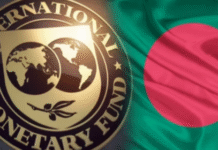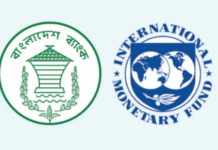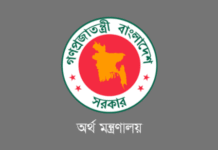
The retail price of coarse rice rose Tk 15 per kilogram in the last one year because of higher prices in the international market, squeezed supply and the coronavirus pandemic, official data showed.
The sharp rise in the food-grain has dealt a major blow to the poor and low-income groups who have been struggling to make ends meet amid massive job losses and a sharp fall in incomes caused by the pandemic.
Coarse rice was selling at Tk 28.59 per kg in November last year and it rose to Tk 43.64 in the first week of October, up 52.64 per cent during the period, provisional data from the Department of Agriculture Marketing showed.
The rice variety mostly consumed by the poor and low-income groups was selling at Tk 31.46 per kg in March and since then it has risen by 38.71 per cent.
The availability of the coarse rice has been squeezed owing to the farmers’ indifference to produce the variety, the coronavirus pandemic and stockpiling by people due to the coronavirus-induced uncertainty, said Food Secretary Mosammat Nazmanara Khanum yesterday.
“What is a little puzzling is that the price has increased despite a good boro harvest and reasonably adequate public stocks. Floods may have been one contributing factor. A shift in demand towards coarse rice because of the decreased incomes of the middle class may also have contributed,” said Zahid Hussain, a former lead economist of the World Bank’s Dhaka office.
However, the economist said, the presence of large players with market power in the rice supply chain may have been the most important factor in the price increase.
A report on the food-grain situation of the country was presented at a meeting of the Food Planning and Monitoring Committee (FPMC) chaired by Food Minister Sadhan Chandra Majumder on Wednesday.
The meeting decided not to take any step to cut the price of rice as such a move would bring down the price of the staple to below the production cost of Tk 40 per kg and dishearten farmers to grow the cereal, said officials of the food and agriculture ministries.
The government would not also cut the duties imposed on rice imports either. Rather, it would boost the sales of coarse rice through the open market sale (OMS) and distribution of the item through other social safety net schemes.
Total import of food-grain was 6.44 million tonnes in FY2019-20, out of which rice was only 4,000 tonnes.
The government has set 0.6 million tonnes of food-grain import target for the ongoing fiscal year. Rice would account for 0.1 million tonnes, according to a document of the food ministry.
On Wednesday, Agriculture Minister Muhammad Abdur Razzaque, however, said the government may need to import 5-6 lakh tonnes of rice and the decision would be taken after the Aman harvest.
“Initially, an initiative has been taken to import 2 lakh tonnes of rice.”
Higher prices in international markets and higher duties have prevented importers from bringing in the staple item.
In Thailand, the price of coarse rice rose to $457 per tonne in October this year from $387 in November last year. It was $341 per tonne in Vietnam a year ago which went up to $462 in October.
The price of coarse rice was more stable in India: it was $363 per tonne in November and edged up to $369 in October, data compiled by the food ministry showed.
Private importers have not brought in any rice in the last one year. There is 62 per cent duty on rice imports, said Majumder.
Based on the estimates, there is approximately 70 per cent chance that the price of coarse rice would vary between Tk 38.39 and Tk 41.59 per kg from October to December, the FPMU said.
After the completion of the upcoming Aman rice harvest, the price would become stable as seen during the same period a year earlier, the report said.
Food Secretary Khanum said the government would not reduce the duty on rice imports as the cut would boost imports.
“If the price of rice goes down below the production cost, the farmers would not be interested to keep producing the coarse rice,” she said.
The FPMC on Wednesday instructed the government to activate various social safety net programmes to support the poor and the vulnerable.
“We are widening the footprint of the OMS of rice,” the food secretary said.
The government has distributed 20,000 tonnes of rice as of October 15 of the current fiscal year under the OMS programme, up from 1,000 tonnes during the same period a year ago.
Khanum said the distribution of rice through the Vulnerable Group Development (VGD) and Vulnerable Group Feeding (VGF) programmes has not grown proportionately as cash is also provided as part of the initiatives.
The government distributed 100,000 tonnes and 101,000 tonnes of rice under the VGF and the VGD programmes as of October 15, which was 151,000 tonnes and 98,000 tonnes respectively during the same period a year ago.
In total, 600,000 tonnes of rice were distributed from July 1 to October 15, down from 666,000 tonnes year-on-year, data from the food ministry showed.
Zahid Hussain said the increase in the price of coarse rice is a double whammy for the poor and low-income families at a time when incomes are either stagnant or declining largely due to the pandemic.
Whether or not collusion between the large players has led to the price increase, this is something the authorities need to look into very carefully, he said.
The government should consider reducing or even removing the high duty on the import of rice and making it easier for new players to enter the market, Hussain said.
“This will increase the contestability of the market and make it risky for the existing large players to engage in profiteering by hoarding.”
Management of the food-based safety net programmes also needs to improve, he said.
“This will help the poor and the vulnerable and also help keep the market price of rice stable. Assistance to farmers will also be important to incentivise increased supply.”









